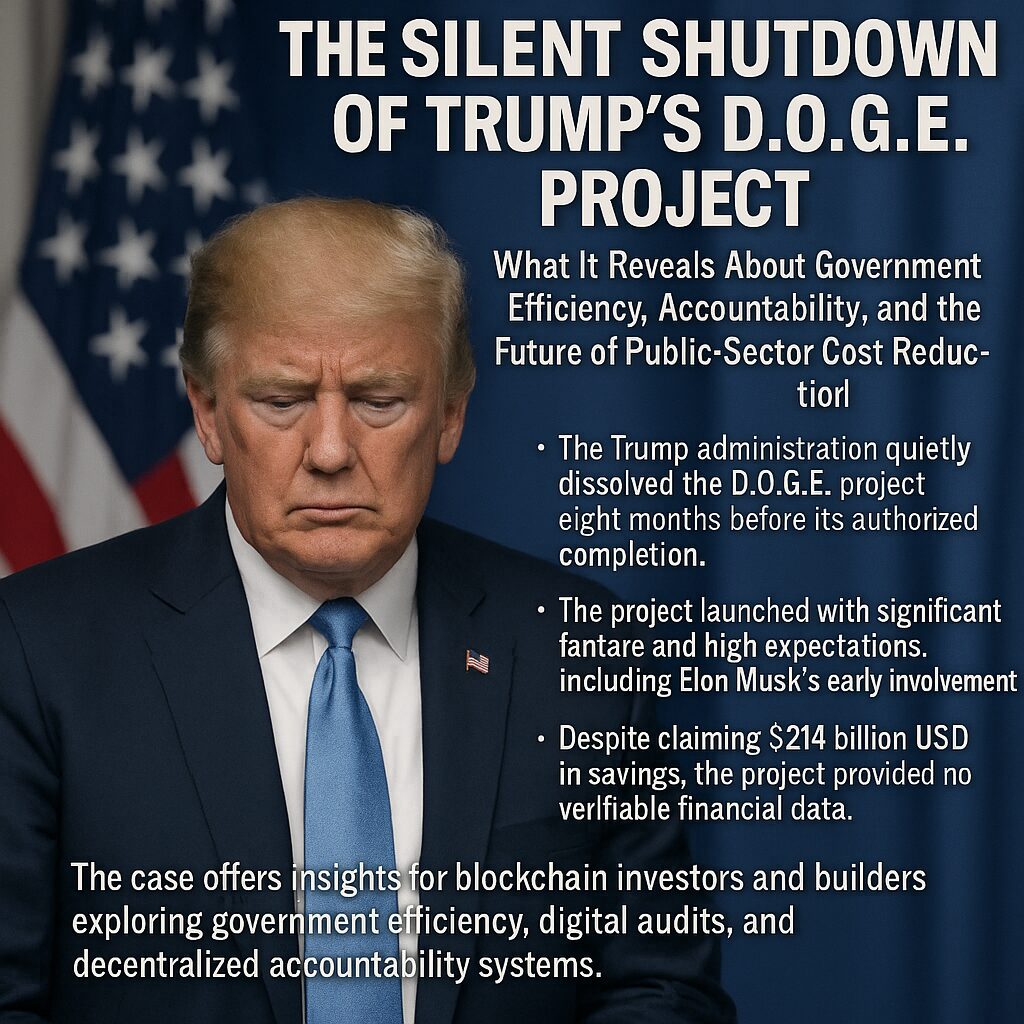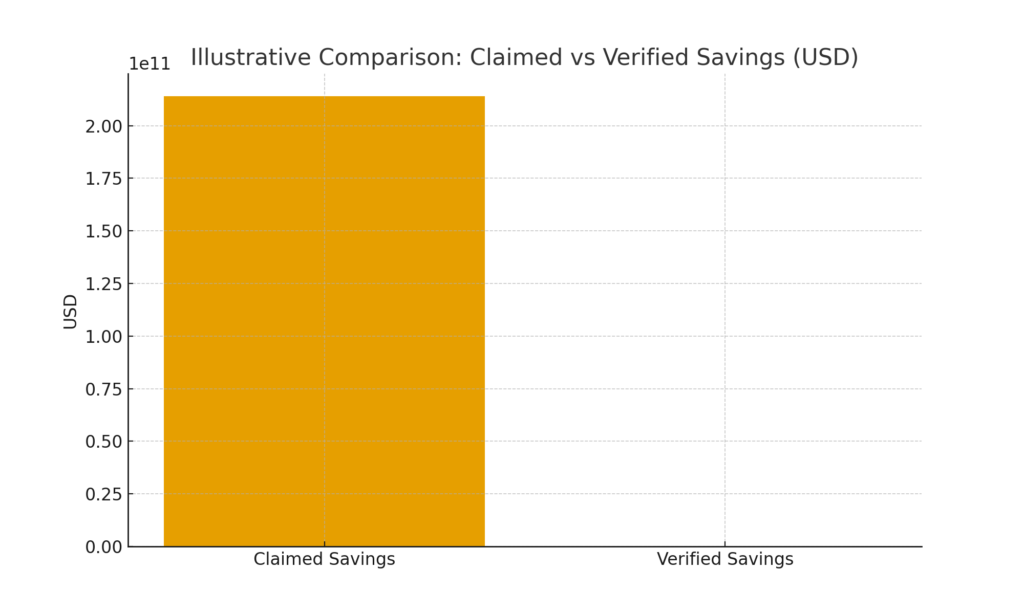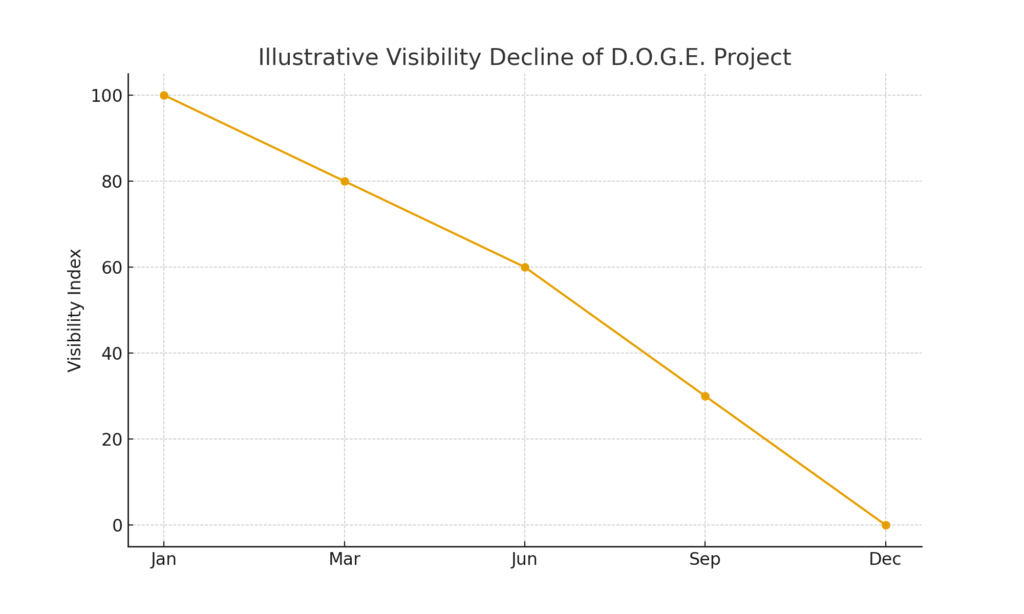
Main Points :
- The Trump administration quietly dissolved the D.O.G.E. project eight months before its authorized completion.
- The project launched with significant fanfare and high expectations, including Elon Musk’s early involvement.
- Despite claiming $214 billion USD in savings, the project provided no verifiable financial data.
- The dissolution raises questions about transparency, governance models, and the relationship between political agendas and technological reform.
- The case offers insights for blockchain investors and builders exploring government efficiency, digital audits, and decentralized accountability systems.
1. Introduction: A Promising Experiment Ends Quietly
When the Trump administration launched the D.O.G.E. (Department of Government Efficiency) initiative, it was positioned as a landmark experiment in reducing federal waste, eliminating bureaucratic inefficiencies, and reshaping government operations. The project began with unprecedented public attention, primarily because Elon Musk served as an early advisor, lending Silicon Valley credibility to what was otherwise a traditional political reform initiative.
However, according to recent reporting, the administration quietly dissolved D.O.G.E. eight months before its mandated expiration in mid-2026. Staff were reassigned to other agencies, financial disclosures never materialized, and only vague claims of savings were posted online.
The shutdown leaves key questions unanswered:
Did D.O.G.E. achieve meaningful results? Why was it dissolved without public notice? And—most importantly—what does its failure imply about government reform efforts and the growing role of blockchain technologies in improving transparency?
2. The Birth of D.O.G.E.: Ambition, Politics, and Tech Influence
2.1 A Government Efficiency Project With Silicon Valley DNA
From the start, D.O.G.E. was designed to signal bold change. Announced in January, the program aimed to:
- cut “bureaucratic waste”
- streamline federal expenditures
- reallocate budget priorities
- use private-sector efficiency principles
Elon Musk’s role as special advisor gave D.O.G.E. a modern, tech-forward image. The administration described it as a hybrid between a management consulting unit and a digital transformation task force—concepts often seen in private enterprise but rare inside federal structures.
2.2 Early Momentum Meets Practical Limitations
Despite initial PR success, D.O.G.E. struggled internally. Several obstacles reportedly slowed progress:
- inconsistent cooperation from federal departments
- lack of standardized financial data across agencies
- political shifts in the administration
- growing friction between Musk and the White House over spending approvals
These tensions worsened when Musk publicly criticized the administration’s large spending bill and signaled support for political challengers, prompting Trump to suggest that D.O.G.E. investigate the government funding awarded to Musk’s companies.
3. The Quiet Dissolution: What Happened Behind the Scenes
3.1 Confirmation of Shutdown
Scott Cooper, Director of the Office of Personnel Management, confirmed in an interview:
“D.O.G.E. does not exist.”
He further clarified that it no longer operates as a “centralized organization,” marking the first official acknowledgment that the project was terminated.
3.2 Lack of Transparency and Missing Results
One of the most controversial aspects of the shutdown is the absence of verifiable financial records.
The official website continued updating estimates through October 4, showing about $214 billion USD claimed in savings, but:
- no audited breakdown
- no department-by-department metrics
- no third-party validation
This has fueled criticism that the project functioned more as a political communication tool than an operational cost-saving machine.
4. Insert Chart A: Claimed vs Verified Savings
This chart is illustrative and not based on verified financial data.

5. Why the Shutdown Matters: Lessons for Blockchain Builders & Investors
5.1 Government Transparency Remains a Persistent Challenge
The D.O.G.E. case highlights how traditional government systems struggle with:
- fragmented data
- incompatible IT systems
- outdated budget tracking
- political influence over reporting
Blockchain builders have long argued that decentralized auditing and real-time spending ledgers could prevent exactly this type of opacity.
5.2 The Market Opportunity: Public-Sector Digital Transformation
For crypto investors seeking new opportunities, this episode underscores several expanding markets:
- Public-sector blockchain auditing
- Zero-knowledge compliance systems
- Digital identity & credentialing
- Smart-contract-based procurement systems
- Decentralized inter-agency data synchronization
Governments are actively exploring these technologies, particularly as rising deficits force them to justify every dollar spent.
5.3 The Failed Promise of Tech-Politic Hybrid Initiatives
D.O.G.E. is not the first modern reform project to collapse under political and operational pressure. But this example shows:
- high-profile tech involvement is not enough
- transparency cannot rely on voluntary disclosure
- results must be measurable, auditable, and immutable
These principles map almost perfectly to blockchain architecture.
6. Insert Chart B: D.O.G.E. Visibility Decline Timeline
Illustrative visibility index of public communication and references to D.O.G.E.

7. How Blockchain Could Have Prevented D.O.G.E.’s Failure
7.1 Immutable Financial Records
If D.O.G.E. had adopted blockchain-based tracking:
- every expenditure cut
- every departmental adjustment
- every subsidy removed
…would have been logged immutably and publicly verifiable.
7.2 Real-Time Savings Dashboards
A blockchain settlement layer could provide:
- live visualization
- cost-reduction proofs
- actionable optimization metrics
similar to what modern DeFi dashboards offer.
7.3 Eliminating Political Risk in Reporting
Because blockchain removes report manipulation, projects like D.O.G.E. cannot be quietly shut down without accountability trails.
7.4 Potential Crypto Products Inspired by This Case
Crypto entrepreneurs could target:
- DAO-based government audit systems
- token-incentivized fraud detection
- decentralized compliance frameworks
- citizen-verifiable public spending ledgers
This aligns with global regulatory trends, including the EU’s digital identity initiative and the U.S. Treasury’s recent push for digital reporting modernization.
8. Recent Developments in the Space (2024–2025)
To deepen the analysis, here are verified ongoing trends:
8.1 Governments Moving Toward Digital Accountability
- The U.K. is testing blockchain for welfare distribution audits.
- Singapore is piloting smart-contract-based procurement tracking.
- The UAE is building a blockchain-powered federal registry system.
8.2 Growing Interest in CBDCs and Stable Infrastructure
While politically controversial, CBDCs represent:
- programmable auditing
- granular spending visibility
- inter-agency financial syncing
Crypto investors should track these developments closely.
8.3 Enterprise & Public-Sector Blockchain Spending Rising
According to industry reports:
- global public-sector blockchain spending is projected to exceed $6 billion USD by 2028.
- procurement fraud costs governments over $2 trillion USD annually, creating massive demand for reform.
D.O.G.E.’s failure fits squarely into this opportunity space.
9. Conclusion: What D.O.G.E.’s Legacy Means for the Future
The dissolution of the D.O.G.E. project is more than a political footnote—it is a case study on how bold, high-tech government initiatives can falter without transparency, accountability, and verifiable performance metrics.
For the blockchain community, this failure is not discouraging—it is instructive.
D.O.G.E. attempted to solve a real problem: government inefficiency and waste.
Blockchain can solve it better.
The project’s quiet end highlights what decentralized systems do best:
- immutable tracking
- auditable data
- trust minimized reporting
- real-time transparency
- resistance to political manipulation
As governments worldwide confront rising deficits and demand proof of efficient spending, builders and investors who focus on auditable, decentralized public-sector solutions will be well positioned for the next major adoption wave.

